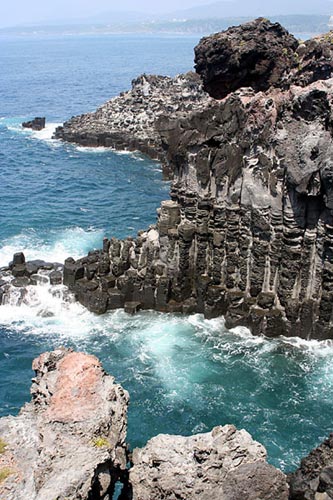Situated in a most ideal setting, just 64 kilometers south of the Korean Peninsula is Korea's largest island, Jeju. Jeju is a magical place known for 3 things: roaring winds, magnificent rocks, and scores of women. Jeju Island, also known as the "Island of the Gods," is a popular vacation spot for Koreans, Chinese and many Japanese. It remains one of the top honeymoon destinations for Korean newlyweds.

ID:109907-00061 Jeju Island Picture Sources:ccnpic.com Wang Yanqing
The island's mixture of volcanic rock, frequent rains, and temperate climate, make it very similar to the Hawaiian Islands in the U.S..
Jeju is a focal point of international affairs and is able to offer people many kinds of recreation with breathtaking vistas, a temperate climate and a unique traditional culture. Located in the center of this volcanically formed island is Mt. Hallasan (a dormant volcano) that South Korea's highest peak, which is filled with over 1,800 species of vegetation, scores of deer, and an ecosystem that will surely amaze all. The island offers visitors a wide range of activities: hiking on Halla-san, catching sunrises and sunsets over the ocean, viewing majestic waterfalls, riding horses, or just lying around on the sandy beaches.
Jeju offers unbelievably breathtaking views from coast to coast, ranging from the waterfalls at Hae-anjidae to the naturally sculpted cliffs at Jusang Jeolli. Tourists can enjoy each season in Jeju with a particular splash of color; brilliant yellow-colored flowers in the spring that spread across the landscape, the golden beaches and sea vistas in the summertime, the Eulalia's light brown wispy reeds flowing in the autumn winds, and the lovely snow flowers of Hallasan in winter are all must-sees of Jeju. The island has a mild marine climate. It has four distinct seasons and an average yearly temperature of 15°C.
You can enjoy these wonderments by hiking, bike riding, paragliding, scuba diving, windsurfing, hunting, horseback riding, swimming in the ocean, and sightseeing boat trips. Jeju also has a wide variety of native foods, such as the delicious Jeju tangerines and native dishes including: redtile fish stew, grilled redtile fish with seasoning, rice porridge with abalone, pheasant dishes and hair-tail fish soup. (CCNPIC Tony Xie)
(Article Resource: www.ccnpic.com)